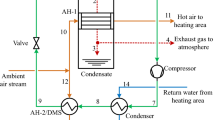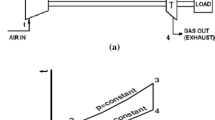Abstract
This article is considering the continuous development of heat pump and refrigeration systems. The sub-cooler and flash tank have been described as effective methods to improve efficiency in the mentioned systems. Also, the intermediate pressure optimization in each of these methods has a significant impact on their efficiency. Therefore, it is important to compare these optimized cycles and determine the effect of this replacement on economic and environmental aspects. In this paper, the flash tank heat pump (FTHP) was optimized based on flash tank pressure, and the optimized sub-cooler heat pump (SCHP) cycle was modeled according to experimental data. The optimum flash tank pressure in the FTHP cycle was obtained by considering operating conditions equal to 872 kPa with the best coefficient of performance (COP) and exergy efficiency of 1.885 and 0.023, respectively. Through comparing the two optimized cycles under the same operating conditions, it was found that the FTHP cycle has a superior COP and exergy efficiency compared to the SCHP cycle, according to the first and second laws of thermodynamics. On the other hand, by performing economic and environmental analyses on SCHP and FTHP cycles, it was observed that using the FTHP cycle over the SCHP cycle saves electricity 507.82 (GWh/year), reduces CO2 emissions by 298.11 (thousand tons/year), and decreases the costs by ~ 58 (million dollars /year) for large-scale heat pumps in seven European countries such as Sweden, Finland, Norway, Italy, Switzerland, France, and Denmark.











Similar content being viewed by others
Data Availability
Data are available to present upon the request of readers.
Abbreviations
- PEm:
-
The price factor of emission ($ kg−1)
- PEE:
-
The price factor of electrical energy ($ kWh−1)
- CER:
-
CO2 emission reduction (ton)
- EFC:
-
The emission factor of carbon \(({\text{kg}}_{{{\text{CO}}_{2} }}\) kWh−1)
- SEE:
-
Saving electricity energy (MWh)
- \(\mathop {Ex}\limits^{ \cdot }\) :
-
Exergy rate (kW)
- h :
-
Enthalpy (kJ kg−1)
- \(\dot{m}\) :
-
Mass flow rate (kg s−1)
- P :
-
Pressure (kPa)
- \(\dot{Q}\) :
-
Heat transfer (kW)
- s :
-
Specific entropy (kJ kg−1 K−1)
- T :
-
Temperature (K)
- \(\dot{W}\) :
-
Power consumption (kW)
- \(\eta\) :
-
Efficiency
- 0:
-
Ambient
- Comp:
-
Compressor
- hp:
-
High pressure
- in:
-
Inlet
- lp:
-
Low pressure
- out:
-
Outlet
- COP:
-
Coefficient of performance
- FTHP:
-
Flash tank heat pump
- SCHP:
-
Sub-cooler heat pump
References
Reilly A, Kinnane O. The impact of thermal mass on building energy consumption. Appl Energy. 2017;198:108–21. https://doi.org/10.1016/j.apenergy.2017.04.024.
Maddah S, Deymi-Dashtebayaz M, Maddah O. 4E analysis of thermal recovery potential of industrial wastewater in heat pumps: An invisible energy resource from the Iranian casting industry sector. J Clean Prod. 2020;29: 121824.
Majuri P. Ground source heat pumps and environmental policy–The Finnish practitioner’s point of view. J Clean Prod. 2016;15(139):740–9.
Lund R, Ilic DD, Trygg L. Socioeconomic potential for introducing large-scale heat pumps in district heating in Denmark. J Clean Prod. 2016;15(139):219–29.
Chang Y, Gu Y, Zhang L, Wu C, Liang L. Energy and environmental implications of using geothermal heat pumps in buildings: An example from north China. J Clean Prod. 2017;20(167):484–92.
Noorollahi Y, Bigdelou P, Pourfayaz F, Yousefi H. Numerical modeling and economic analysis of a ground source heat pump for supplying energy for a greenhouse in Alborz province. Iran J Clean Prod. 2016;10(131):145–54.
Zhu D, Wang B, Ma H, Wang H. Evaluating the vulnerability of integrated electricity-heat-gas systems based on the high-dimensional random matrix theory. CSEE J Power and Energy Syst. 2020;6(4):878–89. https://doi.org/10.17775/CSEEJPES.2019.00440.
Tan K, Qin Y, Du T, Li L, Zhang L, Wang J. Biochar from waste biomass as hygroscopic filler for pervious concrete to improve evaporative cooling performance. Construc Build Mater. 2021;287:123078. https://doi.org/10.1016/j.conbuildmat.2021.123078.
Zhu L, Yu JL, Zhou ML, Wang X. Performance analysis of a novel dual-nozzle ejector enhanced cycle for solar assisted air-source heat pump systems. Renew Energy. 2014;63:735–40.
Park C, Lee H, Hwang Y, Radermacher R. Recent advances in vapor compression cycle technologies. Int J Refrig. 2015;60:118–34.
Lumpkin DR, Bahman AM, Groll EA. Two-phase injected and vapor-injected compression: experimental results and mapping correlation for a R-407C scroll compressor. Int J Refrig. 2018;86:449–62. https://doi.org/10.1016/j.ijrefrig.2017.11.009.
Song M, Deng S, Dang C, Mao N, Wang Z, Wu P, He J, Chen L, Wu Y, Li HH, Zhu H, Li HH, Zhu W, Song M, Deng S, Dang C, Mao N, Wang Z. Review on improvement for air source heat pump units during frosting and defrosting. Appl Energy. 2018;211:1150–70. https://doi.org/10.1016/j.apenergy.2017.12.022.
Wallerand AS, Kermani M, Kantor I, Maréchal F. Optimal heat pump integration in industrial processes. Appl Energy. 2018;219:68–92. https://doi.org/10.1016/j.apenergy.2018.02.114.
Roh CW, Yoo JW, Kim MS. Vapor refrigerant injection techniques for heat pump systems: the latest literature review and discussion. Int J Air-Conditioning Refrig. 2014;22:1430002. https://doi.org/10.1142/S201013251430002X.
Baek C, Heo J, Jung J, Lee E, Kim Y. Effects of vapor injection techniques on the heating performance of a CO2 heat pump at low ambient temperatures. Int J Refrig. 2014;43:26–35.
Redon A, Navarro-Peris E, Pitarch M, Gonzalvez-Macia J, Corberan JM. Analysis and optimization of subcritical two-stage vapor injection heat pump systems. Appl Energy. 2014;124:231–40.
Younghwan Ko a, Sangkyoung Park a, Simon Jin a, Byungsoon Kim a, Ji Hwan Jeong. The selection of volume ratio of two-stage rotary compressor and its effects on air-to-water heat pump with flash tank cycle. Appl Energy 104 (2013) 187–196
Kwon O, Cha D, Park C. Performance evaluation of a two-stage compression heat pump system for district heating using waste energy. Energy. 2013;57:375–81. https://doi.org/10.1016/j.energy.2013.05.012.
Rad EA, Maddah S. Entropic optimization of the economizer’s pressure in a heat pump cycle integrated with a flash-tank and vapor-injection system. Int J Refrig. 2018. https://doi.org/10.1016/j.ijrefrig.2018.09.018.
Rad EA, Maddah S, Mohammadi S, Designing and optimizing a novel cogeneration system for an office building based on thermo-economic and environmental analyses, Renew Energy. (2019).
Deymi-Dashtebayaz M, Maddah S, Fallahi E. Thermo-economic-environmental optimization of injection mass flow rate in the two-stage compression refrigeration cycle (Case study: Mobarakeh Steel Company in Isfahan, Iran). Int J Refrig. 2019 Jun 21.
Baek C, Heo J, Jung J, Cho H, Kim Y. Performance characteristics of two-stage CO2 heat pump water heater adopting a sub-cooler vapor injection cycle at various operating conditions. Energy. 2014;77:570–8.
Cho IY, Seo H, Kim D, Kim Y. Performance comparison between R410A and R32 multi-heat pumps with a sub-cooler vapor injection in the heating and cooling modes. Energy. 2016;112:179–87.
Heo J, Jeong MW, Baek C, Kim Y. Comparison of the heating performance of air-source heat pumps using various types of refrigerant injection. Int J Refrig. 2011;34:444–53. https://doi.org/10.1016/j.ijrefrig.2010.10.003.
Heo JY, Kang H, Kim YC. Optimum cycle control of a two-stage injection heat pump with a double expansion sub-cooler. Int J Refrigeration. 2012;35:58–67.
Zhang L, Bhatti MM, Michaelides EE, Marin M, Ellahi R. Hybrid nanofluid flow towards an elastic surface with tantalum and nickel nanoparticles, under the influence of an induced magnetic field. The Eur Phys J Special Topics. 2021;27:1–3.
Kalvin R, Taweekun J, Maliwan K, Ali HM. Fabrication of catalytic converter with different materials and comparison with existing materials in addition to analysis of turbine installed at the exhaust of 4 stroke SI engine. Sustainability. 2021;13(18):10470.
Bhatti MM, Michaelides EE. Study of Arrhenius activation energy on the thermo-bioconvection nanofluid flow over a Riga plate. J Therm Anal Calorim. 2021 Feb;143(3):2029–38.
Sajjad U, Sadeghianjahromi A, Ali HM, Wang CC. Enhanced pool boiling of dielectric and highly wetting liquids–A review on surface engineering. Appl Therm Eng. 2021;1(195): 117074.
Tariq HA, Anwar M, Malik A, Ali HM. Hydro-thermal performance of normal-channel facile heat sink using TiO2-H2O mixture (Rutile–Anatase) nanofluids for microprocessor cooling. J Therm Anal Calorim. 2021;145(5):2487–502.
Deymi-Dashtebayaz M, Maddah S, Goodarzi M, Maddah O. Investigation of the effect of using various HFC refrigerants in geothermal heat pump with residential heating applications. J Therm Anal Calorim. 2020;141(1):361–72.
Maddah S, Safaei MR. Determination of the optimal discharge pressure of the transcritical CO2 heat pump cycles for heating and cooling performances based on new correlation. J Therm Anal Calorim. 2021;145(3):1537–46.
Bhatti MM, Riaz A, Zhang L, Sait SM, Ellahi R. Biologically inspired thermal transport on the rheology of Williamson hydromagnetic nanofluid flow with convection: an entropy analysis. J Therm Anal Calorim. 2021;144(6):2187–202.
Web Site of Bitzer Company, www.bitzer.de (accessed 2019).
Parsa SM, Yazdani A, Dhahad H, Alawee WH, Hesabi S, Norozpour F, Javadi D, Ali HM, Afrand M. Effect of Ag, Au, TiO2 metallic/metal oxide nanoparticles in double-slope solar stills via thermodynamic and environmental analysis. J Clean Prod. 2021;15(311): 127689.
Maddah S, Goodarzi M, Safaei MR. Comparative study of the performance of air and geothermal sources of heat pumps cycle operating with various refrigerants and vapor injection. Alex Eng J. 2020;59(6):4037–47.
Brander AM, Sood A, Wylie C, Haughton A, Lovell J, Reviewers I, Davis G. Electricity-specific emission factors for grid electricity. Ecometrica. 2011. https://doi.org/10.13044/j.sdewes.2014.02.0030.
EIA-Electricity Data [WWW Document], n.d. URL https://www.eia.gov/electricity/monthly/epm_table_grapher.php?t=epmt_5_6_a (accessed 10.31.18).
Sanaye S, Ghafurian MM, Dastjerd FT. Applying relative net present or relative net future worth benefit and exergy efficiency for optimum selection of a natural gas engine based CCHP system for a hotel building. J Nat Gas Sci Eng. 2016;34:305–17. https://doi.org/10.1016/J.JNGSE.2016.06.038.
David A, Mathiesen BV, Averfalk H, Werner S, Lund H. Heat roadmap Europe: large-scale electric heat pumps in district heating systems. Energies. 2017;10(4):578.
Author information
Authors and Affiliations
Contributions
Conceptualization was carried out by S.M., M.G., and M.H.; methodology by S.M. and M.H.; software by S.M. and M.H.; validation by S.M. and M.H.; formal analysis by S.M. and C.X.L.; investigation by H.M. and M.H.; resources by S.M. and M.H.; data curation by S.M.; writing—original draft preparation—by S.M. and M.G.; writing—review and editing—by M.G., M.R.S., and C.X.L.; visualization by C.X.L.; supervision by M.R.S. and M.G.; project administration by M.R.S. and M.G. All authors have read and agreed to the published version of the manuscript.
Corresponding author
Ethics declarations
Conflict of interest
The authors declare no conflict of interest.
Additional information
Publisher's Note
Springer Nature remains neutral with regard to jurisdictional claims in published maps and institutional affiliations.
Rights and permissions
Springer Nature or its licensor holds exclusive rights to this article under a publishing agreement with the author(s) or other rightsholder(s); author self-archiving of the accepted manuscript version of this article is solely governed by the terms of such publishing agreement and applicable law.
About this article
Cite this article
Maddah, S., Hadizadeh, M., Goodarzi, M. et al. Technical, economic, and environmental feasibility of replacing a flash tank with a sub-cooler in heat pump system. J Therm Anal Calorim 147, 13757–13768 (2022). https://doi.org/10.1007/s10973-022-11520-3
Received:
Accepted:
Published:
Issue Date:
DOI: https://doi.org/10.1007/s10973-022-11520-3




